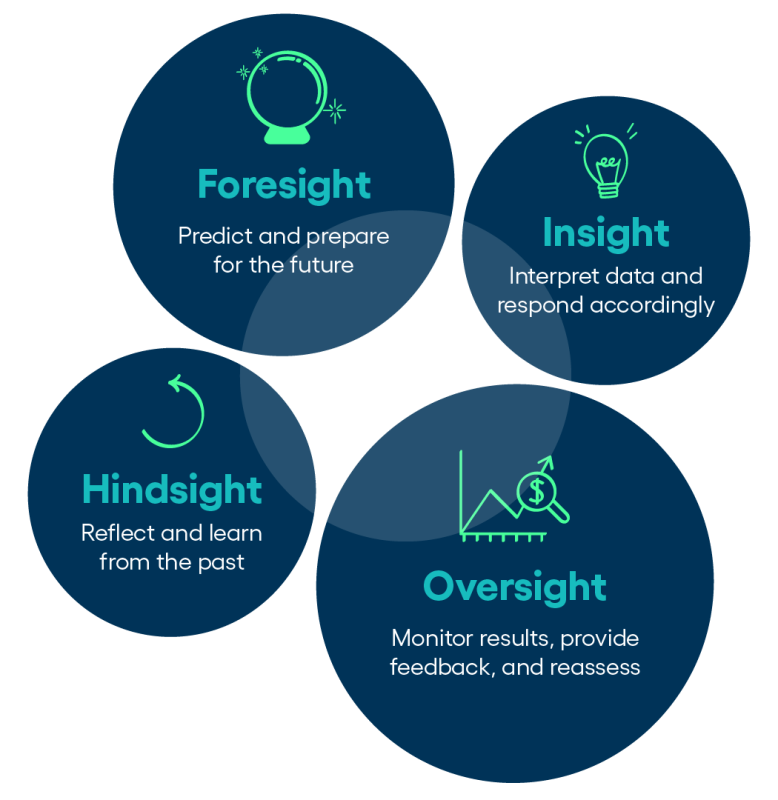The 4 Sight Framework: A Roadmap to Financial Transparency for K-12 Business Officers
Being a K-12 business officer comes with a lot of responsibility. You’re at the center of it all—connecting school leadership, facilities teams, and the broader community to make decisions that affect students and staff every day. It’s a big job, and with the added pressure on districts to demonstrate stronger fiscal responsibility, demonstrating financial transparency in your decision-making is more important than ever.
Financial transparency isn’t just about sharing numbers. It’s about showing how decisions were made, why certain priorities were chosen, and how resources are being used to support the district’s goals. When done right, it builds trust with your Board of Education, staff, and the community as a whole. And that trust is the foundation for making decisions that truly serve everyone.
To help streamline the decision-making process, the “4 Sight Framework” is a simple technique that can guide business officers in blending past lessons, current needs, and future goals into one cohesive strategy. Here’s how it works.
What is the “4 Sight Framework?”
The 4 Sight Framework is a strategic decision-making model that emphasizes financial transparency, data-driven insights, and stakeholder trust, making it particularly valuable for K-12 business officers and other decision-makers.

The framework consists of four interconnected components:
1. Hindsight to learn from the past
We all know hindsight is 20/20, and that’s what this first step is all about. Take a good look at past decisions. Did those budget allocations actually work the way you planned? Were those infrastructure upgrades worth it? What would you do differently next time?
Reflecting on the past helps you learn what works and builds trust with your community because you’re showing that you’re learning and growing from experience.
2. Foresight to plan for the future
Next up is foresight—essentially, planning for what’s coming down the road. What will your district need next year? Five years from now? Are you seeing enrollment growth? Are some of your buildings in desperate need of upgrades?
This is your chance to think proactively. By looking at trends like demographics, funding changes, or new technology, you can budget smarter and prepare your district for the future instead of scrambling when challenges pop up unexpectedly.
3. Insight to focus on today
Now, let’s talk about insight. This step is all about understanding what your district needs right now. What do the numbers say about your facilities? How energy-efficient are your buildings? What are parents and staff telling you about their priorities?
Getting a clear picture of the present helps you make better decisions about where to focus your resources. It’s about solving today’s problems while keeping the big picture in mind.
4. Oversight to ensure accountability
Finally, there’s oversight. This is where you follow through. Work closely with your facilities teams to keep projects on track, monitor progress, and measure the results. Are things going the way they should? What can you adjust or improve next time?
Oversight isn’t just about checking boxes—it’s about showing your district that you’re paying attention and making sure their resources are being used wisely.
Why transparency matters
Financial transparency is more than a best practice—it’s the foundation for trust and accountability. By clearly communicating how and why decisions are made, you can build confidence with your Board of Education, staff, and community members.
The 4 Sight Framework provides a practical roadmap for making smarter, more transparent decisions. Whether you adopt the full framework or take inspiration from its principles, this approach helps education leaders balance priorities, create sustainable financial plans, and ensure that every decision supports students, staff, and the district’s mission.
In the end, fostering transparency isn’t just about numbers; it’s about trust. And that trust is what allows districts to thrive—today, tomorrow, and in the years to come.
For more trends and strategies designed to help education leaders effectively maintain their facilities and infrastructure, download a free copy of our recent K-12 Business Officer’s Guide to Facilities Asset Management.



